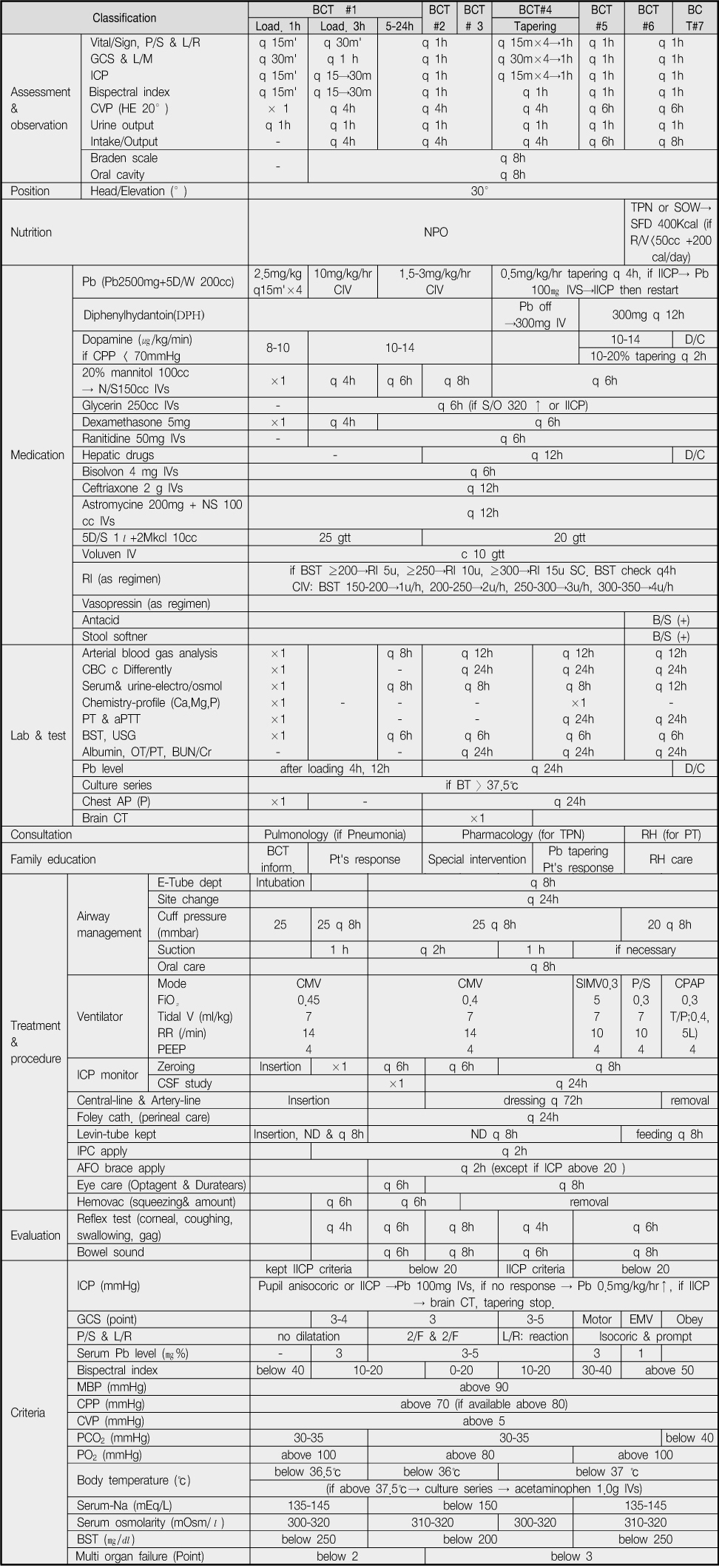1Nursing Director, Intensive Care Unit, Samsung Medical Center; Concurrent Professor, Sungkyunkwan University Graduate School of Clinical Nursing Science, Korea.
Copyright © 2010 Korean Academy of Nursing Administration
This article is a revision of the author's doctoral dissertation from Chung-Ang University.



Based on analysis of medical records on critical pathway change
ATS=According to situation; B/S=Bowel sound; BT=Body temperature; CPP=Cerebral perfusion pressure;
CVP=Central venous pressure; ICP=Intra cranial pressure; MBP=Mean blood pressure; Pb=Pentobarbital; TS=Time schedule.
Analysis on the variation of barbiturate coma therapy (N=76)
CPP=Cerebral perfusion pressure; CVP=Central venous pressure; GCS=Glasgow coma scale; MBP=Mean blood pressure;
Pb=Pentobarbital; S-Na Serum Na(mEq/l); S-Osmol=Serum osmolarity(mOsm/l).
General characteristics of patients (N=88)
*Fisher's exact test
APACHE II=Acute Physiology and Chronic Health Evaluation II; CPICH=Clinical phase of intracranial hypertension;
GCS=Glasgow coma scale; SAH=Subarachnoid hemorrhage.
Comparison on intervention of critical pathway between two groups (N=88)
CPP=Cerebral Perfusion Pressure; CVP=Central venous pressure; MBP=Mean blood pressure;
P/S & L/R=Pupil size & light reflex; SBP=Systolic blood pressure
Comparison on the outcomes of Barbiturate coma therapy between two groups (N=88)
*Survival group=Control(n=52); CP apply(n=10)
DRS=Disability rating scale; GCS=Glasgow coma scale; ICU=Intensive care unit.
ATS=According to situation; B/S=Bowel sound; BT=Body temperature; CPP=Cerebral perfusion pressure; CVP=Central venous pressure; ICP=Intra cranial pressure; MBP=Mean blood pressure; Pb=Pentobarbital; TS=Time schedule.
CPP=Cerebral perfusion pressure; CVP=Central venous pressure; GCS=Glasgow coma scale; MBP=Mean blood pressure; Pb=Pentobarbital; S-Na Serum Na(mEq/
*Fisher's exact test APACHE II=Acute Physiology and Chronic Health Evaluation II; CPICH=Clinical phase of intracranial hypertension; GCS=Glasgow coma scale; SAH=Subarachnoid hemorrhage.
CPP=Cerebral Perfusion Pressure; CVP=Central venous pressure; MBP=Mean blood pressure; P/S & L/R=Pupil size & light reflex; SBP=Systolic blood pressure
*Survival group=Control(n=52); CP apply(n=10) DRS=Disability rating scale; GCS=Glasgow coma scale; ICU=Intensive care unit.

